A High-Frequency-Compatible Miniaturized Bandpass Filter with Air-Bridge Structures Using GaAs-Based Integrated Passive Device Technology
Abstract
:1. Introduction
2. Materials and Methods
2.1. Equivalent Circuit
2.2. Current Density
3. Results and Discussion
4. Conclusions
Author Contributions
Funding
Conflicts of Interest
References
- Su, L.; Naqui, J.; Mata-Contreras, J.; Martin, F. Miniature microwave notch filters and comparators based on transmission lines loaded with stepped impedance resonators (SIRs). Micromachines 2015, 7, 1–10. [Google Scholar] [CrossRef]
- Liang, L.G.; Wang, C.; Kim, N.Y. Dual-band ultra-wideband bandpass filter with eight-resonant modes and quad-transmission zeros employing synchronous-quasi-resonance. Radioengineering 2017, 26, 713–720. [Google Scholar] [CrossRef]
- Liang, L.G.; Wang, C.; Kim, N.Y. Implementation of ultra-wideband bandpass filter with modularized design based on synchronous-quasi-resonance and double-curved-route. IET Microw. Antennas Propag. 2018. [Google Scholar] [CrossRef]
- White, J.F. High Frequency Techniques: An Introduction to RF and Microwave Design and Computer Simulation, 1st ed.; John Wiley & Sons: Hoboken, NJ, USA, 2004; pp. 335–398. ISBN 978-0-471-45591-2. [Google Scholar]
- Hong, J.S.; Lancaster, M.J. Microstrip Filters for RF/microwave Applications, 1st ed.; John Wiley & Sons: Hoboken, NJ, USA, 2001; pp. 1–6. ISBN 0-471-22161-9. [Google Scholar]
- Sebastian, M.T.; Jantunen, H. Low loss dielectric materials for LTCC applications: A review. Int. Mate. Rev. 2008, 53, 57–90. [Google Scholar] [CrossRef]
- Simon, R.W.; Hammond, R.B.; Berkowitz, S.J.; Willemsen, B.A. Superconducting microwave filter systems for cellular telephone base stations. Proc. IEEE 2004, 92, 1585–1596. [Google Scholar] [CrossRef]
- Yao, J.J. RF MEMS from a device perspective. J. Micromech. Microeng. 2000, 10, R9. [Google Scholar] [CrossRef]
- Kunze, M.; Heinrich, W. Hybrid dynamic-quasi-static finite-difference analysis of MMIC components with non-ideal conductivity. AEU-Int. J. Electron. Commun. 2003, 57, 137–146. [Google Scholar] [CrossRef]
- Bowick, C. RF Circuit Design, 2nd ed.; Elsevier: New York, NY, USA, 2007; pp. 37–62. ISBN 978-0-750-68518-4. [Google Scholar]
- Hsu, C.Y.; Chen, C.Y.; Chuang, H.R. A 77-GHz CMOS on-chip bandpass filter with balanced and unbalanced outputs. IEEE Electron Device Lett. 2010, 31, 1205–1207. [Google Scholar] [CrossRef]
- Yang, Y.; Zhu, H.; Zhu, X.; Xue, Q. A Low-loss bandpass filter using edge-coupled resonator with capacitive feeding in (Bi)-CMOS technology. IEEE Electron Device Lett. 2018, 39, 787–790. [Google Scholar] [CrossRef]
- Nan, L.; Mouthaan, K.; Xiong, Y.Z.; Shi, J.L.; Rustaagi, S.C.; Ooi, B.L. Design of 60-and 77-GHz narrow-bandpass filters in CMOS technology. IEEE Trans. Circuits Syst. 2008, 55, 738–742. [Google Scholar] [CrossRef]
- Pant, R.; Marpaung, D.; Kabakova, I.V.; Morrison, B.; Poulton, C.G.; Eggleton, B.J. On-chip stimulated Brillouin Scattering for microwave signal processing and generation. Laser Photon. Rev. 2014, 8, 653–666. [Google Scholar] [CrossRef]
- Zhang, W.; Minasian, R.A. Widely tunable single-passband microwave photonic filter based on stimulated Brillouin scattering. IEEE Photon. Technol. Lett. 2011, 23, 1775–1777. [Google Scholar] [CrossRef]
- Casas-Bedoya, A.; Morrison, B.; Pagani, M.; Marpaung, D.; Eggleton, B.J. Tunable narrowband microwave photonic filter created by stimulated Brillouin scattering from a silicon nanowire. Opt. Lett. 2015, 40, 4154–4157. [Google Scholar] [CrossRef] [PubMed] [Green Version]
- Chen, J.H. Enhancement of 5 GHz on-chip bandpass filter performance by using CMOS-MEMS inductors. Microsyst. Technol. 2018, 24, 2371–2377. [Google Scholar] [CrossRef]
- Jafari, B.; Sheikhaei, S. Pseudo-impulse tail current shaping for phase noise reduction in CMOS LC oscillators. Microelectron. J. 2018, 74, 60–68. [Google Scholar] [CrossRef]
- Jeon, H.; Kim, N.Y. A compact quadrature coupler on GaAs IPD process for LTE applications. IEICE Electron. Express 2013, 10, 20130386. [Google Scholar] [CrossRef]
- Wang, C.; Kim, N.Y. Analytical optimization of high-performance and high-yield spiral inductor in integrated passive device technology. Microelectron. J. 2012, 43, 176–181. [Google Scholar] [CrossRef]
- Li, Y.; Wang, C.; Kim, N.Y. A high performance compact Wilkinson power divider using GaAs-based optimized integrated passive device fabrication process for LTE application. Solid-State Electron. 2015, 103, 147–153. [Google Scholar] [CrossRef]
- Kim, E.S.; Kim, N.Y. Micro-fabricated resonator based on inscribing a meandered-line coupling capacitor in an air-bridged circular spiral inductor. Micromachines 2018, 9, 294. [Google Scholar] [CrossRef]
- Haobijam, G.; Palathinkal, R.P. Design and Analysis of Spiral Inductors, 1st ed.; Springer: New York, NY, USA, 2013; pp. 21–51. ISBN 978-81-322-1514-1. [Google Scholar]
- Choi, B.H.; Jin, Z.J.; Kim, M.G.; Sun, H.; Yun, T.Y. Equivalent-circuit model based on mathematical analysis for multilayer chip inductors. IET Microw. Antennas Propag. 2008, 2, 378–382. [Google Scholar] [CrossRef]
- Aryan, N.P. Design and Modeling of Inductors, Capacitors and Coplanar Waveguides at Tens of GHz Frequencies., 1st ed.; Springer: New York, NY, USA, 2014; pp. 19–34. ISBN 978-3-319-10187-3. [Google Scholar]
- Pakasiri, C.; Hsu, K.C.; Wang, S. Low-loss and highly-selective differential bandpass filter on integrated passive device process. Microw. Opt. Technol. Lett. 2018, 60, 970–975. [Google Scholar] [CrossRef]
- Sitaraman, S.; Sukumaran, V.; Pulugurtha, M.R.; Wu, Z.; Suzuki, Y.; Kim, Y.; Sundaram, V.; Kim, J.; Tummala, R.R. Miniaturized bandpass filters as ultrathin 3-D IPDs and embedded thinfilms in 3-D glass modules. IEEE Trans. Compon. Packag. Manuf. Technol. 2017, 7, 1410–1418. [Google Scholar] [CrossRef]
- Li, C.H.; Yu, M.C.; Lin, H.J. A compact 0.9-/2.6-GHz dual-band RF energy harvester using SiP technique. IEEE Microw. Wirel. Compon. Lett. 2017, 27, 666–668. [Google Scholar] [CrossRef]
- Wong, K.W.; Mansour, R.R.; Weale, G. Reconfigurable bandstop and bandpass filters with wideband balun using IPD technology for frequency agile applications. IEEE Trans. Compon. Packag. Manuf. Technol. 2017, 7, 610–620. [Google Scholar] [CrossRef]
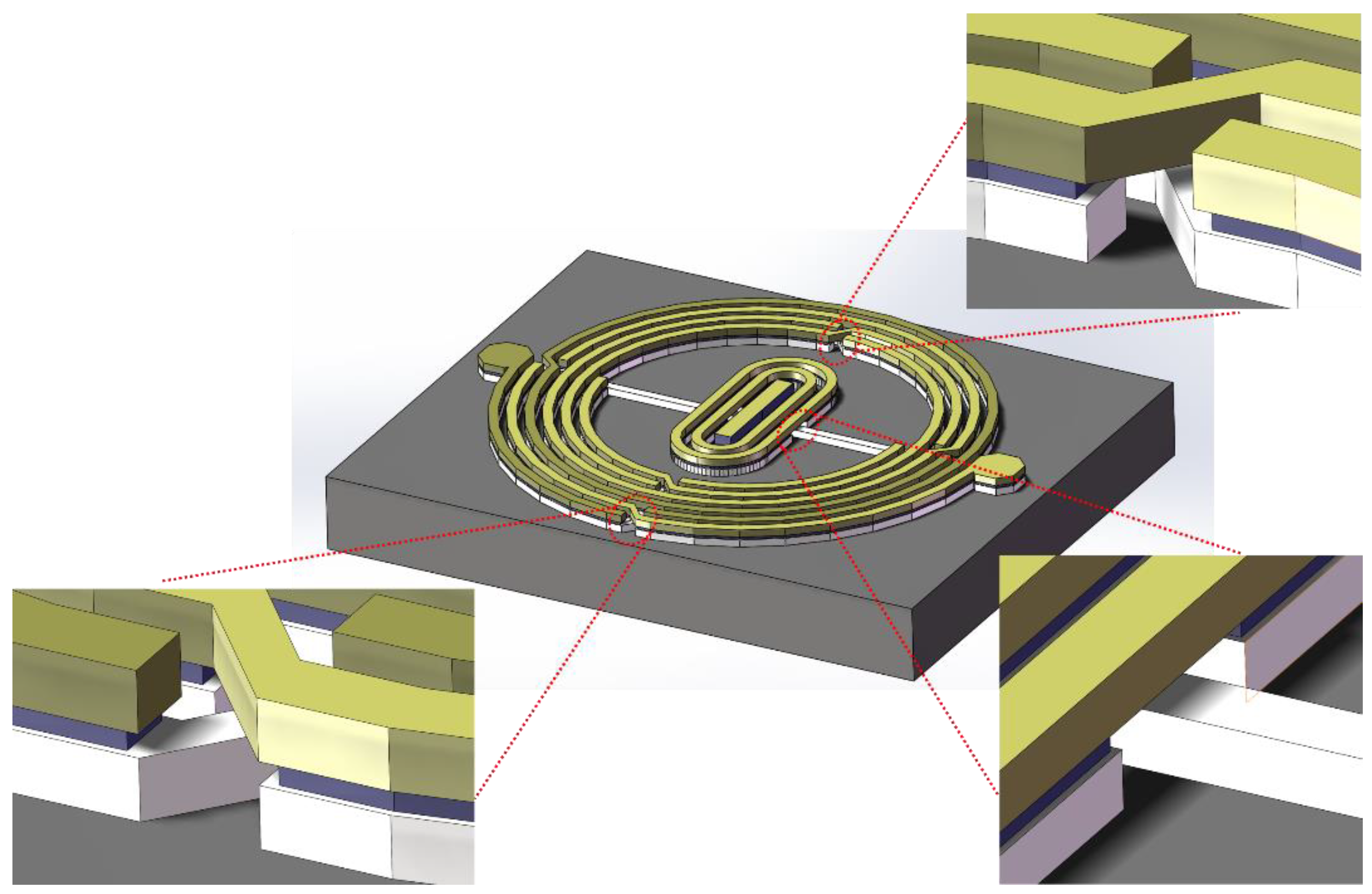
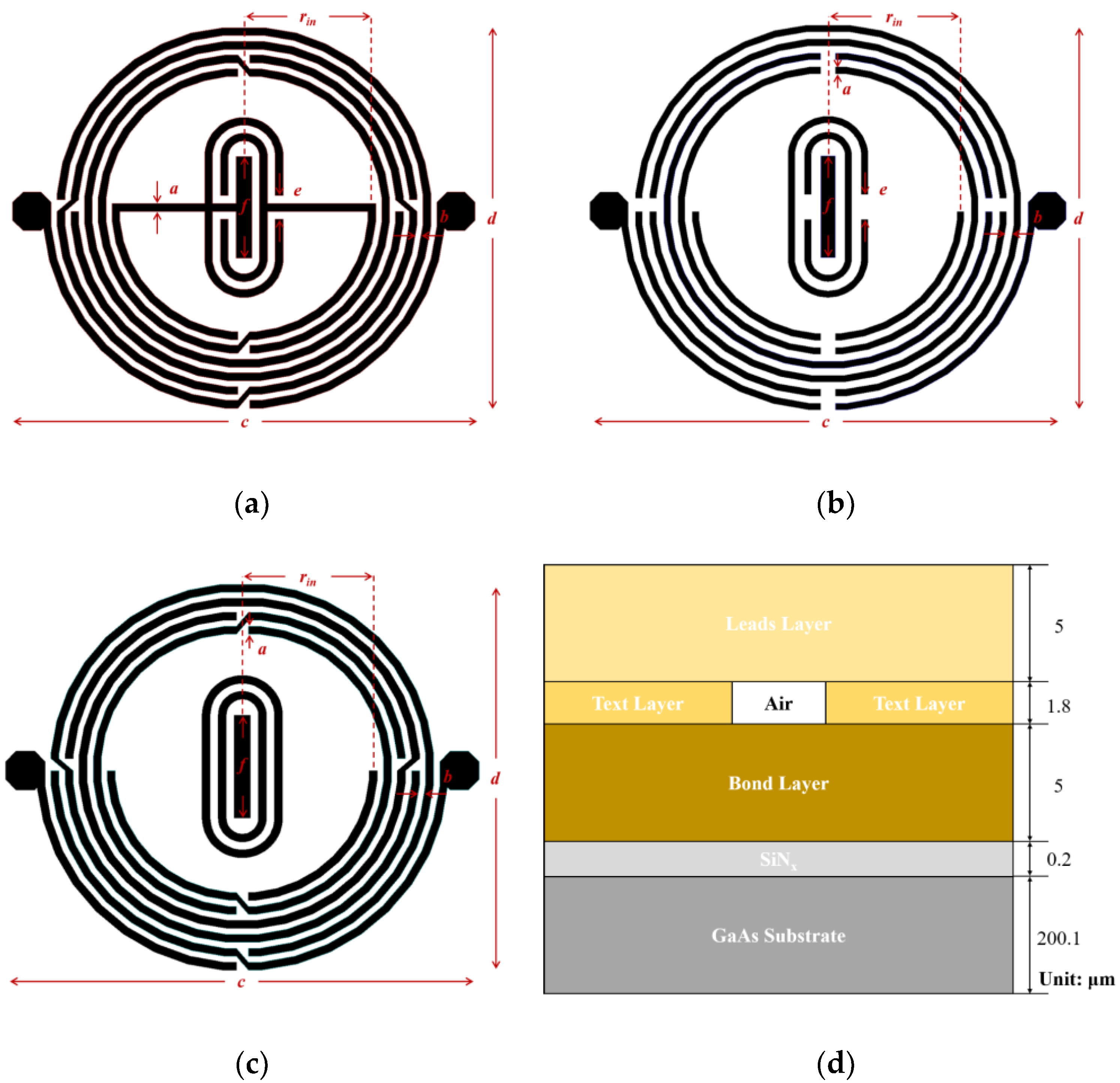
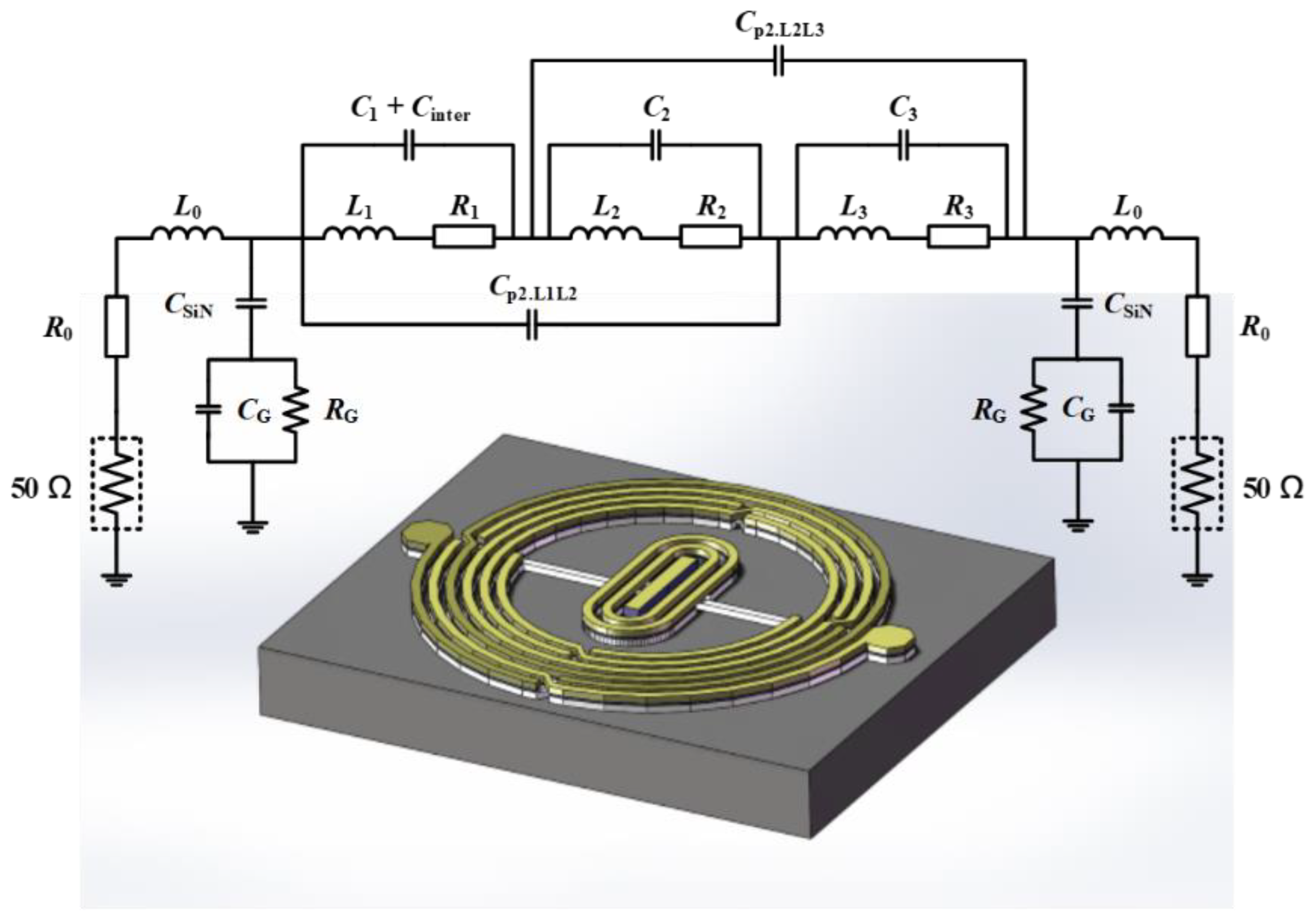
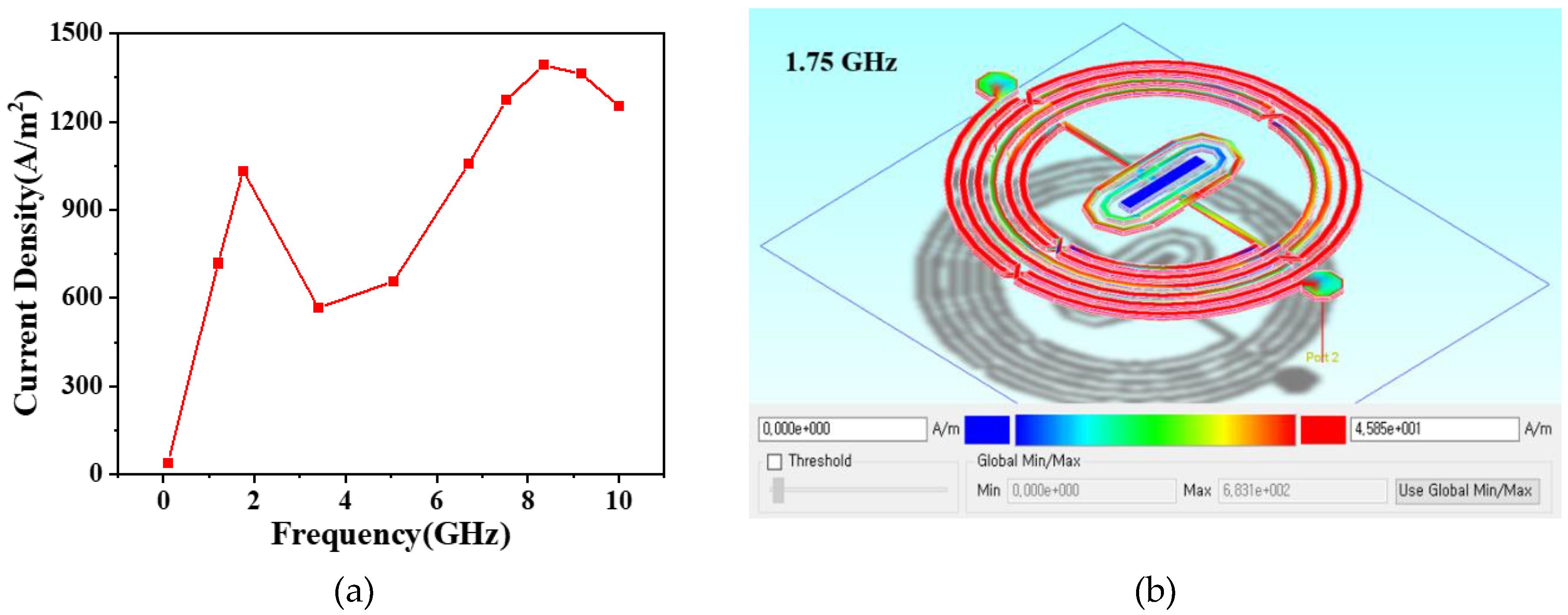
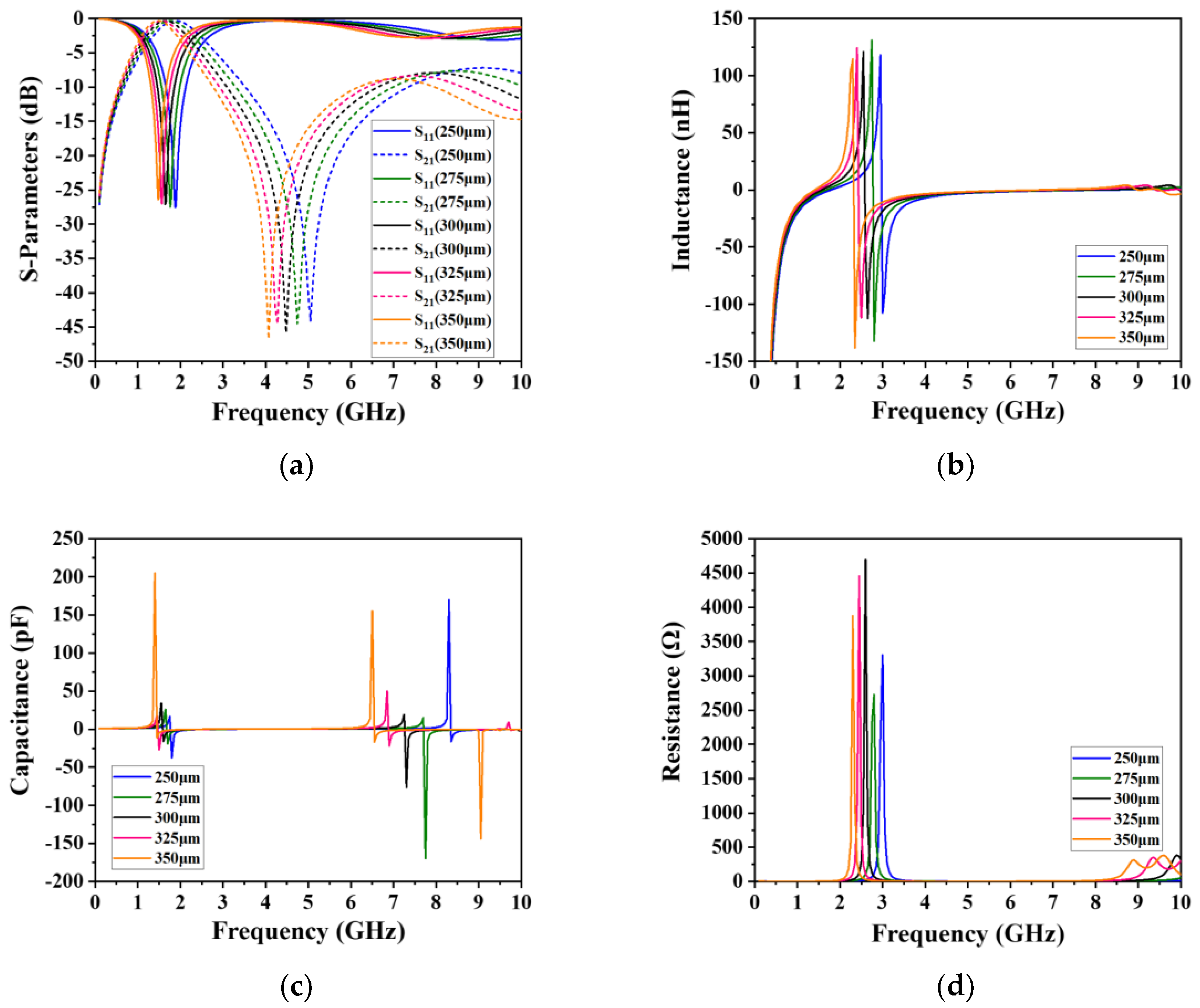


| Parameter | a | b | c | d | e | f | rin |
|---|---|---|---|---|---|---|---|
| Unit (μm) | 20 | 15 | 1178.5 | 970 | 60 | 258.7 | 300 |
| Parameter | a | b | c | d | e | f | rin |
|---|---|---|---|---|---|---|---|
| Unit (μm) | 16 | 19 | 1174.5 | 966 | 64 | 254.7 | 300 |
| Parameter | a | b | c | d | e | f | rin |
|---|---|---|---|---|---|---|---|
| Unit (μm) | 20 | 15 | 1178.5 | 970 | N/A | 258.7 | 300 |
| Terms | (GHz) | (GHz) | (GHz) | (GHz) | (GHz) | FBW (%) | (GHz) |
|---|---|---|---|---|---|---|---|
| 250 μm | 2.026 | 2.749 | 1.303 | 2.749 | 1.893 | 76.401 | 5.066 |
| 275 μm | 1.929 | 2.625 | 1.234 | 2.625 | 1.800 | 77.233 | 4.703 |
| 300 μm | 1.834 | 2.519 | 1.148 | 2.519 | 1.701 | 80.581 | 4.474 |
| 325 μm | 1.775 | 2.451 | 1.099 | 2.451 | 1.641 | 82.397 | 4.315 |
| 350 μm | 1.694 | 2.352 | 1.037 | 2.352 | 1.562 | 84.232 | 4.063 |
© 2018 by the authors. Licensee MDPI, Basel, Switzerland. This article is an open access article distributed under the terms and conditions of the Creative Commons Attribution (CC BY) license (http://creativecommons.org/licenses/by/4.0/).
Share and Cite
Wang, Z.-J.; Kim, E.-S.; Liang, J.-G.; Qiang, T.; Kim, N.-Y. A High-Frequency-Compatible Miniaturized Bandpass Filter with Air-Bridge Structures Using GaAs-Based Integrated Passive Device Technology. Micromachines 2018, 9, 463. https://doi.org/10.3390/mi9090463
Wang Z-J, Kim E-S, Liang J-G, Qiang T, Kim N-Y. A High-Frequency-Compatible Miniaturized Bandpass Filter with Air-Bridge Structures Using GaAs-Based Integrated Passive Device Technology. Micromachines. 2018; 9(9):463. https://doi.org/10.3390/mi9090463
Chicago/Turabian StyleWang, Zhi-Ji, Eun-Seong Kim, Jun-Ge Liang, Tian Qiang, and Nam-Young Kim. 2018. "A High-Frequency-Compatible Miniaturized Bandpass Filter with Air-Bridge Structures Using GaAs-Based Integrated Passive Device Technology" Micromachines 9, no. 9: 463. https://doi.org/10.3390/mi9090463





